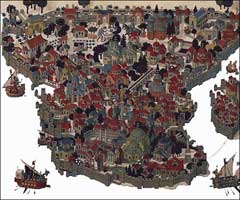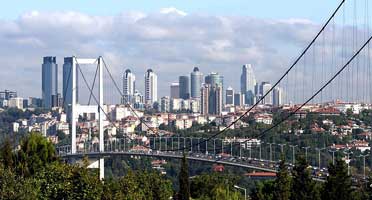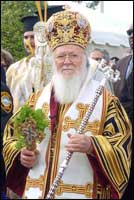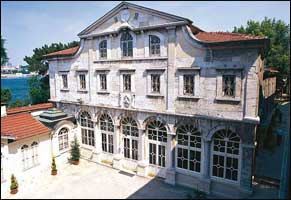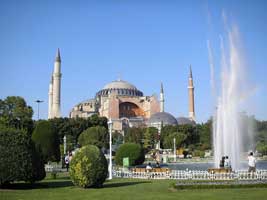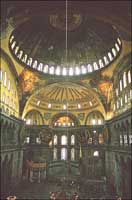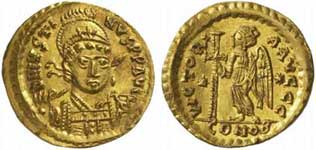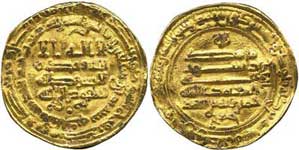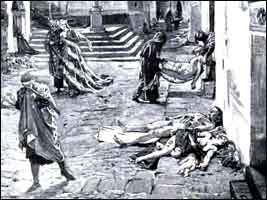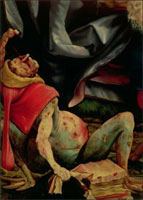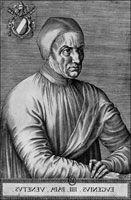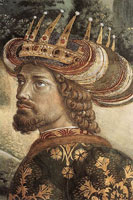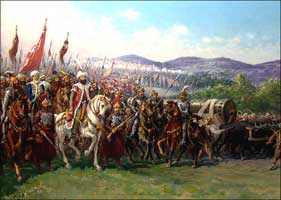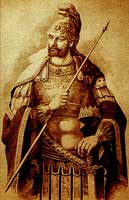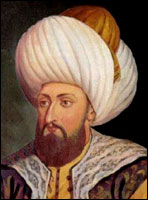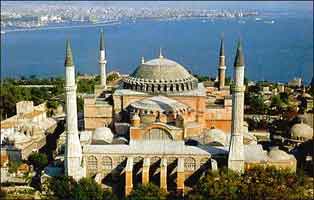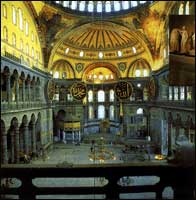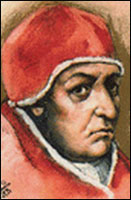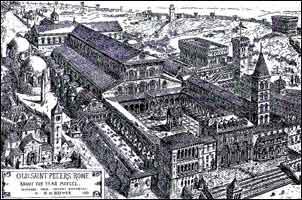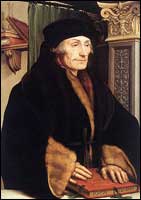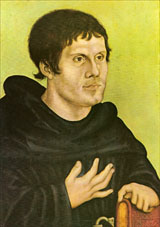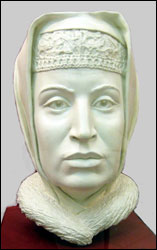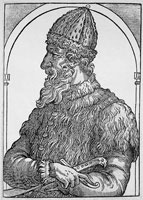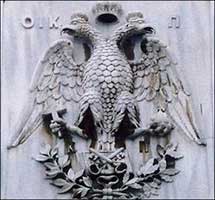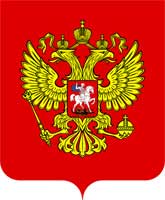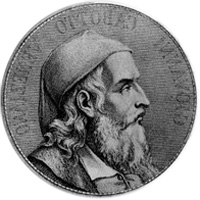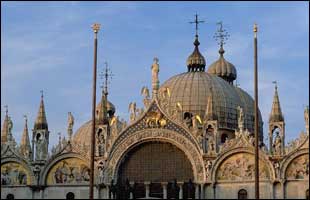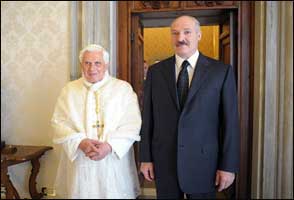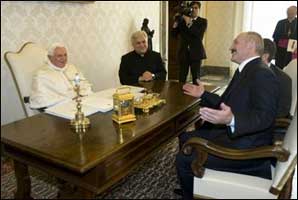| |
The
Fall of Constantinople to the Muslim Turks in 1453 |
|
|
May 29, 1453– May 29, 2014 |
|
May
29 (New Style) and June 11 (Old Style) is the 557th anniversary of a
day that will live in infamy....That day commemorates the Fall of Constantinople—the
Queen of Cities—to the Muslim Turks.
For
almost 1000 years, Old Rome fought fiercely by every means
possible—even enlisting the help of Saint
Peter himself—to
overthrow her eastern rival, Constantinople.
All
of her efforts were in vain until the fateful year of 1453.
The
Fall of Constantinople seemed like a tremendous victory, but it was
a Pyrrhic victory, because it led to the 3 greatest events of the last
centuries of world history....These 3 great events were:
1. |
|
2. |
|
3. |
The
rise of Orthodox Christian Russia.
|
Constantinople,
bridging Europe and Asia, was the most important city in the world until
1453.
|
| |
The
City of Constantinople was called the Queen of Cities.
It
is also built on 7 hills and was called New Rome.
|
|
|
| |
Constantinople
is now called Istanbul. |
|
Constantinople
was greatly weakened by the 4th Crusade and the brutal Latin occupation
from 1202 to 1261. Constantinople was finally conquered by the Muslim
Turks in 1543 and renamed Istanbul.
Patriarch Bartholomew
I is a virtual prisoner of the Turks in Istanbul
Since
the conquest by the Muslims, the Orthodox Patriarchs have been virtual
prisoners in their own city. The situation is even worse today with
the Patriarch of Constantinople
receiving
death threats daily and having to live behind barbed wire and security
cameras.
|
|
| |
Old Rome's
millenarian rival—the Eastern Patriarch—is a
virtual prisoner of the Muslim Turks.
At
the Vatican they are "praying" that he will soon
leave permanently.
What
more proof is needed that Islam is the military arm of the
Vatican!! |
|
|
| |
Very
modest headquarters of the Patriarch. |
|
When
Pope Pius IX lost the temporal power in 1870, he was allowed to continue
living at the Vatican. Still, he raised hell and called himself a "prisoner
of the Vatican." After 1453, the Turks turned Hagia Sophia it into
a mosque, and Kemal Ataturk turned it into a museum in 1935.
| |
Exterior
view of Hagia Sophia surrounded by minarets. |
|
| |
Hagia Sophia
(Gk. Holy Wisdom) was the headquarters of the Eastern Patriarchs
for over 1000 years.
In
1453, Hagia Sophia was turned into a mosque, and Kemal Ataturk
turned it into a museum in 1935.
|
|
|
| |
Interior
view of Hagia Sophia showing verses from the Koran. |
|
Hagia
Sophia was the largest basilica in the world for nearly 1000 years.
Today, it is a tourist attraction and the Pope of the Orthodox Church
has just a few small buildings as his headquarters!!
Constantinople
gave the world a stable currency for 800 years!!
As
well as preserving the manuscripts of the New Testament, Constantinople
gave the world a stable currency for about 800 years (400-1200). It
was called the BEZANT.
Emperor
Constantine stripped the pagan temples of centuries of accumulated gold,
and that gold was minted into SOLIDI or BEZANTS. The gold served a far
higher purpose as circulating money than bedecking lifeless images.
The
BEZANT was a stable gold currency accepted by countries from Hibernia
to China:
Not
only was money in abundance at Constantinople, center of a far flung
political and commercial hegemony, but the bezants struck with the
imperial seal became the accepted medium of exchange throughout the
civilized world. Indubitable evidence of the regard for Byzantine
coinage are the nomisma with names of the Byzantine emperors
of the fourth, fifth, and sixth centuries which have been found in
southern and western India, and in the Mongol hoards which were uncovered
during the Indian Mutiny of 1856. The bulk of these coins, incidentally,
were not carried to India by Byzantine merchants, but by Persians
and Abyssinians, who evidently regarded them as more generally acceptable
than the productions of their own mints.
And in Europe the bezants served in all important payments
where gold passed hands. Either because of respect for the authority
of the Eastern Empire, as Del Mar believes, or because of the prestige
of the Byzantine gold and the profusion with which it was minted,
the European princes and feudal lords never minted gold on their own
account. In England, for instance, we learn from the exchequer rolls
of the Middle Ages, payments in bezants were the ordinary thing where
gold was used. (Groseclose, Money and Man,
p. 50).
The
main competition to the BEZANT was the Arabic DINAR. Dinar is translated
as PENNY in the English Bible. Dinar comes from the old Roman word denarius
which was current money during the time of pagan Rome.
| |
Emperor
Justinian's gold bezant or solidis. |
|
| |
The
Arabic DINAR was the main competition for the bezant until
1202. |
|
|
|
The
bezant was HONEST money and accepted worldwide.
After
the Fourth Crusade, Genoa, Venice and Florence began issuing their own
money and the bezant began a steady decline until its demise in 1453.
If not for the Discovery of the New World and the blessed Reformation,
the Arabic dinar would have become the universal currency centuries
ago!!
The
4th Crusade of 1202 greatly weakened New Rome!!
The
Crusades were launched for 2 main reasons:
1. |
Massacre
the Muslim Arabs for making peace with Constantinople. |
| 2. |
Annex
the Eastern Roman Empire to the Latin West. |
After
the disastrous defeat following the siege of Constantinople by Caliph
Muawiyah I (674–679), the Arabs developed a healthy respect
for the fighting abilities of the Eastern Romans . . . and Greek
Fire.
Both
religions developed a healthy respect for each other and actually lived
in peace:
In
the middle of the eleventh century the tranquility of the east Mediterranean
world seemed assured for many years to come. Its two great powers,
Byzantium and Fatimid Egypt, were on good terms with each other. Neither
was aggressive; both wished to keep in check the Moslem states further
to the east, where adventurers from Turkestan were stirring up trouble,
which as yet did not seem serious. The Fatimids showed goodwill towards
the local Christians and welcomed merchants and pilgrims from the
West; and this goodwill was guaranteed by the power of Byzantium.
(Runciman, The First Crusade, p. 23).
This
friendship with Constantinople by the Arabs was anathema to Old Rome
because the Arab conquests had been financed by Old Rome at tremendous
cost and now they were on friendly terms with the very enemy they were
supposed to destroy!!
We
see the same situation happening today with the
Pentagon Crusaders destroying Iraq because of its friendship with
Russia!
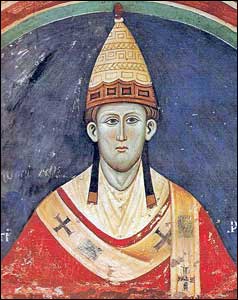
Pope
Innocent III (1160–1216).
Reigned from 1198 to 1216.
|
| Pope
Innocent III launched the
Fourth Crusade in 1202, which saw the conquest and occupation
of Constantinople by the Latins.
The
Latin empire that was established by the Crusaders fell
apart in 1261. |
|
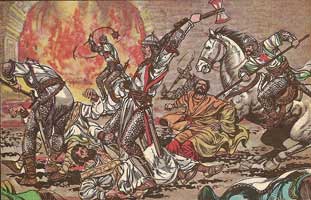
Sack of
Constantinople by the Crusaders.
|
Constantinople
survived the 60 year occupation of the city but was greatly weakened
as a result:
When
Constantinople was captured by the Crusaders and Venetians it was
adorned with the accumulated wealth of centuries and decorated with
art treasures for which not only Greece but the whole Roman Empire
had been ransacked. When the city was recaptured by the Greeks it
was a desolation. Houses, churches, and monasteries were in ruins;
whole quarters were deserted. Heaps of rubbish marked where extensive
fires had consumed houses which no one cared to rebuild. The imperial
palace itself was in so disorderly and filthy a condition that it
was sometime before it could be occupied. In place of a large population
of the most educated and highly civilised people in Europe, was a
miserably small number of Greeks who had been reduced to poverty with
a number of foreign and principally French colonists. While the foreign
captors had plundered the city and carried off the bronze horses of
Lysippus and innumerable other objects of art and value to Western
Europe, they and their successors during the fifty-eight years of
occupation had, in their contemptuous ignorance of the art of a conquered
people, destroyed probably more than had been taken away as plunder.
(Pears, The Destruction of the Greek Empire and the Story of the
Capture of Constantinople by the Turks, p. 22).
The
biological warfare commonly referred to as the Black Death carried away
millions of the inhabitants of the Eastern Roman Empire....This was
not the first such devestating pandemic to afflict the Empire. The wrongly
named "Justinian's Plague" wiped out almost half of the population
between 541 and 750.
| |
Victims
of the Black Death. |
|
| |
The
Black Death, that raged from 1347–1351, was a biological
weapon used against the Eastern Empire.
Painful
BOILS covered the entire body.
75
million men, women and children died.
|
|
|
| |
A
victim of the Black Death. |
|
Such
massive mortality rates were not seen until the Spanish Flu of 1918.
Bubonic
plague was not the "wrath of God" but an international
example of what Satan did to ONE man—Job:
So
Satan went out from the presence of JEHOVAH, and struck Job with painful
BOILS from the sole of his foot to the
crown of his head (Job 2:7).
This
pestilence drastically reduced the population of the Eastern Empire.
It went out of control and also ravaged Western Europe:
Lastly,
the depopulation caused by the terrible diseases which visited Europe
in the century preceding the Moslem conquest aided greatly in destroying
the empire. The prevalence of Black Death or Plague killed in the
Balkan peninsula and especially in the towns hundreds of thousands
and possibly millions of the population. In 1347 this scourge, probably
the most deadly form of epidemic that has ever afflicted humanity,
made its appearance in Eastern Europe. The cities of the empire contained
large populations crowded together, and their normal population was
increased by many fugitives. These crowded cities, with their defective
sanitary arrangements and poverty-stricken inhabitants, offered a
favourable soil for a rich harvest of death. The disease had followed
the coasts from the Black Sea, where, says Cantacuzenus, it had carried
off nearly all the inhabitants. At Constantinople it raged during
two years, one of its first victims being the eldest son of Cantacuzenus
himself. Rich as well as poor succumbed to it. What proportion of
the inhabitants of the city died it is impossible to say, but, judging
by what is known of its effect elsewhere, we should probably not be
wrong in suggesting that half the people perished. But its ravages
were not confined to the towns, and from one end of the Balkan peninsula
to the other it swept the country in repeated visitations and
probably carried off nearly the same proportion of inhabitants. Cantacuzenus,
in a vivid description of the disease, adds that the saddest feature
about it was the feeling of hopelessness and despair which it left
behind. (Pears, The Destruction of the Greek Empire
and the Story of the Capture of Constantinople by the Turks,
pp. 189-190).
Naturally,
the Turks were not affected by it:
It
may safely be assumed that the Turks, who lived in the open air, and
in the country rather than in towns, suffered less than the Christians.
Though they are reported to have lost severely, the process of depopulation
scarcely told against them. The places of those who died were taken
by the ever-crowding press of immigrants flocking westward. The
successors of the Greeks who perished were not Christians but Turks.
In other words, while the Christians died out of the land, there were
always at hand Turkish nomads to take their place. (Pears,
The Destruction of the Greek Empire and the Story of the Capture
of Constantinople by the Turks, p. 191).
The
rejection of the Council of Florence sealed the doom of Constantinople.
Rejection
of The Council of Florence sealed the doom of Constantinople!!
The
Council of Florence, which ended on July 5, 1439, was the last great
desperate effort by Old Rome to end the Great Schism before the conquest
of Constantinople by the Turks.
The
Council began in 1431 in Basel, Switzerland, and became known as the
Council of Ferrara after its transfer to Ferrara was decreed by Pope
Eugene IV. The Council transferred to Florence in 1439 because of the
danger of plague at Ferrara, and because the city of Florence had agreed,
against future payment, to finance the Council.
| |
Pope
Eugene IV (1383–1447).
Pope from 1431 to 1447. |
|
| |
The
Council was the last great event before the Fall of Constantinople.
The
Emperor John VIII Palaiologos actually signed the decrees
but the union was rejected by Saint
Mark of Ephesus and the common people of Constantinople.
|
|
|
| |
John
VIII Palaiologos (1392–1448).
Emperor from 1425 to 1448. |
|
All
the Greeks present at the Council–even the Emperor–signed
the decrees of union . . . except for one man: Saint Mark of Ephesus.
For
his uncompromising stand, Saint Mark died an untimely death at the young
age of 52.
The
voluntary union sought by Old Rome never materialized—so
she unleashed her Muslim Turks against the city only 14 years later.
Constantinople
finally fell to the Terrible Turks in 1453
Old
Rome was finally able to eliminate her Eastern rival in 1453. After
fighting heroically for 1000 years, the Empire finally came to an end.
The
Turkish besiegers numbered about 150,000 troops against about 9,000
defenders. It was the Alamo of the East.
With
all the Turkish superiority in numbers, the Eastern Romans put up an
HEROIC defense of their beloved city which lasted about 2 months.
The
newly invented gunpowder cannon were deployed against the city for the
first time in history.
| |
Huge
Turkish army on the march to Constantinople. |
|
| |
Massive
gunpowder cannon were used for the first time to demolish
the walls of Constantinople. |
|
|
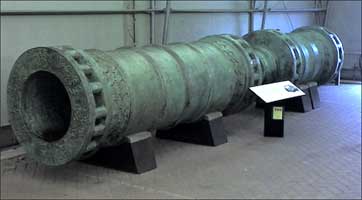 |
Massive
Hungarian Cannon. |
|
Only
the Venetians and Genoese fought side by side with the defenders of
the city.
The
defenders were in a hopeless situation but they held out for 2 months
against the Muslims.
The
Hungarian Cannon, named after the Hungarian engineer Orban, who cast
the gun for the Ottoman besiegers of Constantinople. Today it belongs
to the British Royal Armouries collection.
| |
Constantine
XI (1449–1453).
Considered the last Roman Emperor. |
|
| |
Emperor
Constantine XI did not want to survive the fall of his beloved
city and live under Sharia law where he would be forced
to "pray" 5 times a day to the Black Stone at
Mecca.
He
died sword in hand fighting for his Faith and beloved city.
|
|
|
| |
Sultan
Mehmet II (1449–1481).
Conqueror of Constantinople. |
|
His
body was never recovered for the usual beheading and exhibiting as a
trophy.
The
church of St. Sophia was turned into a SLAUGHTERHOUSE!!
As
the fierce battle raged for control of the city, old men, women and
children sought shelter in the church of St. Sophia. That was their
fatal mistake as the Muslims had no consideration for age or sex.
| |
St. Sophia is now a
mosque. |
|
| |
This
church was the scene of a terrible slaughter as the Turks
went berserk and massacred old men, women and children who
had sought sanctuary within its walls. |
|
|
|
Some
of the prettiest young women were saved alive for a fate worse than
death . . . to become concubines in the harem of the Sultan Mehmet II:
The
church was still thronged. The Holy Liturgy was ended, and the service
of matins was being sung. At the sound of the tumult outside the huge
bronze gates of the building were closed. Inside the congregation
prayed for the miracle that alone could save them. They prayed in
vain. It was not long before the doors were battered down. The worshippers
were trapped. A few of the ancient and infirm were killed on the spot;
but most of them were tied or chained together. Veils and scarves
were torn off the women to serve as ropes. Many of the lovelier maidens
and youths and many of the richer-clad nobles were almost torn to
death as their captors quarrelled over them. Soon a long procession
of ill-assorted little groups of men and women bound tightly together
was being dragged to the soldiers' bivouacs, there to be fought over
once again. The priests went on chanting at the altar till they too
were taken. But at the last moment, so the faithful believed, a few
of them snatched up the holiest vessels and moved to the southern
wall of the sanctuary. It opened for them and - closed behind them;
and there they will remain until the sacred edifice becomes a church
once more. (Runciman, The Fall of Constantinople
1453 , p. 147).
The
name of the city was later changed to Istanbul and St. Sophia was turned
into a mosque.
Jubilation
at the Vatican over the downfall of their rival
Pope
Nicholas V was the first Pope to make St. Peter's Basilica the official
residence of the Popes. He was jubilant at the news of the Fall of Constantinople.
| |
Pope
Nicholas V (1397–1455).
Pope from 1447 to 1455. |
|
| |
Pope
Nicholas V was eternally grateful to the Muslims for conquering
Constantinople.
This
Pope issued a Bull in 1452 calling the Muslims PAGANS and
giving permission to the Portuguese to enslave them.
|
|
|
| |
St.
Peter's Basilica circa 1453. |
|
Just
the previous year, Pope Nicholas issued a Bull calling the Muslims pagans
and giving permission to Portugal to join the Muslim African slave trade:
We
grant you (kings of Portugal) by these present documents, with our
Apostolic Authority, full and free permission to invade, search out,
capture, and subjugate the Saracens and pagans
and any other unbelievers and enemies of Christ wherever they may
be, as well as their kingdoms, duchies, counties, principalities,
and other property and to reduce their persons into perpetual slavery.
(Bull Dum Diversas, 1452).
This
was really the beginning of the European slave trade which would later
ship millions of African slaves to the New World.
The
Orthodox church preserved the Greek New Testament manuscripts
With
the Fall of Constantinople, Old Rome believed that all her troubles
were over....In actuality . . . they were just beginning!
The
Orthodox church preserved the Greek New Testament manuscripts that survived
from the last great pagan persecution under Emperor Diocletian.
When
Constantinople fell, many of the Greek scholars fled to Italy, bringing
their priceless manuscripts with them. This was later to lead to the
Renaissance and Reformation.
Venice–the
adopted homeland of John Cabot–always
had a very special relationship with the Eastern Roman Empire:
Northern
Europe had taken an interest now, too, and its scholars had begun
journeying to Italy, where many of them studied with the same Byzantine
teachers as the Italians. The Dutch scholar who was the greatest of
the northern humanists, Desiderius Erasmus, learned Greek in Venice
with Marcus Musurus. Erasmus' English friend Thomas Linacre, a doctor
and classicist who founded London's Royal College of Physicians, spent
more than a decade in Italy studying Greek with Demetrius Chalcondyles
and Politian, and winning his degree in medicine from the university
of Padua. Linacre was Erasmus' and Sir Thomas More's doctor, and the
close friend of another English humanist, John Colet, who had also
studied in Italy. The German humanist Johannes Reuchlin had come to
Italy in the 1480s, where he studied Greek with John Argyropoulos
in Rome. (Wells, Sailing from Byzantium, p.
113).
All
copies of the original Greek Septuagint and the Old Latin Version were
destroyed by the Latin monks long before the Fall of Constantinople.
| |
Desiderius
Erasmus (1466–1536). |
|
| |
Erasmus scoured
Italy for copies of Greek manuscripts.
He
used these ancient and manuscripts to prepare Latin and
Greek editions of the News Testament.
It
was a Greek edition of Erasmus that Saint Martin Luther
used to produce his German translation. |
|
|
| |
Saint
Martin Luther (1483–1546). |
|
Erasmus
of Rotterdam was the intellectual giant of the Renaissance in Europe.
He was the most learned man of his age. Every university in Europe vied
for the honor of having him as a member of their faculty. He was also
the editor of the Greek New Testament that Saint Martin Luther used
to launch the blessed Reformation. It was said that "Erasmus laid
the egg that Luther hatched." Erasmus had nothing but contempt
for the corrupt clergy. His father and mother, Gerard and Margaret Brandt,
are the subjects of The Cloister
and the Hearth.
William
Tyndale used the same Byzantine text as Saint Martin Luther in his superb
English translation of the New Testament.
Moscow
is the successor of Constantinople!!
The
Triune God, who sees all things in advance, had a new home for the Orthodox
church in Russia.
| |
Zoe
Palaiologina (1455–1503).
Wife of Ivan from 1472 to 1503. |
|
| |
Zoe Palaiologina
was the niece of Emperor Constantine XI.
In
1472,
she married the Grand Duke of Moscow, Ivan III.
Due
to her influence, Moscow became the 3rd Rome, and depository
of the Orthodox faith. |
|
|
| |
Ivan
the Great. (1440–1505).
Reigned from 1462 to 1505. |
|
Due
to her family traditions, she encouraged imperial ideas in the mind
of her husband, Ivan. It was through her influence that the ceremonious
etiquette of Constantinople (along with the imperial double-headed eagle
and all that it implied) was adopted by the court of Moscow.
| |
Double
headed imperial eagle. |
|
| |
The
double-headed eagle was adopted by Ivan III after his marriage
with the Byzantine princess Zoe Palaiologina, whose uncle
Constantine XI, was the last Byzantine Emperor. |
|
|
|
We
shouldn't fail to mention that the Julian calendar was imported to Moscow
from Constantinople, as well as the Greek based Cyrillic alphabet.
The
Fall of Constantinople led to the Discovery of the New World by John
Cabot
John
Cabot was born in Genoa just 3 years prior to the conquest of the city.
He dreamed of emulating Marco Polo and traveling overlandto China.
The
Fall of Constantinople severed the main overland trade link between
Europe and Asia. As a result, he planned on reaching Asia by sailing
westward.
|
| |
John
Cabot's overland route to China was blocked by the Turkish
conquest of Constantinople.
As
a result, he moved to Bristol, England, and planned on sailing
westward to China. |
|
|
| |
San
Marco Cathedral, Venice. |
|
He
made landfall in the New World on June 24, 1494.
Old
Rome is still trying to end the East-West Schism!!
Old
Rome is still trying to end the East-West Schism by using Belarus as
an ecumenical bridge to the Third Rome—Moscow.
| |
Pope
Benedict and Alexander Lukashenko. |
|
| |
On
April 27, 2009, Pope Benedict XVI and Alexander Lukashenko
had a meeting at the Vatican to discuss a union between
the Third Rome and Old Rome!! |
|
|
|
|
Alexander
Jukashenko and Pope Benedict. |
|
Belarus is only
400 kilometers from Moscow and ideally situated for a NATO Crusaders
invasion of that country.
Vital
links
References
Darwish
Nonie. Cruel
and Unusual Punishment:
The Terrifying Global Implications of Islamic Law. Thomas
Nelson Publishers, Nashville, Tennessee, 2008.
Groseclose,
Elgin, Money and Man:
A Survey of Monetary Experience. University of Oklahoma Press,
1934.
Little,
Lester K. Plague
and the End of Antiquity: The Pandemic of 541-750. Cambridge
University Press, London & New York, 2007.
Pears,
Edwin, The
Destruction of the Greek Empire and the Story of the Capture of Constantinople
by the Turks. Haskell House Publishers, New York, 1968.
Runciman,
Sir Steven. The Fall of Constantinople 1453. Cambridge University
Press. London & New York, 1965.
Runciman,
Sir Steven. The First Crusade. Cambridge University Press.
London & New York, 1951.
Wells,
Colin, Sailing From Byzantium. How a Lost Empire Shaped the World.
Delacorte Press, New York, 2006.
Warraq,
Ibn. Why
I Am Not a Muslim. Prometheus Books, Amherst, New York, 1995.
Copyright
© 2013 by Patrick Scrivener
Back
to Main Menu | 